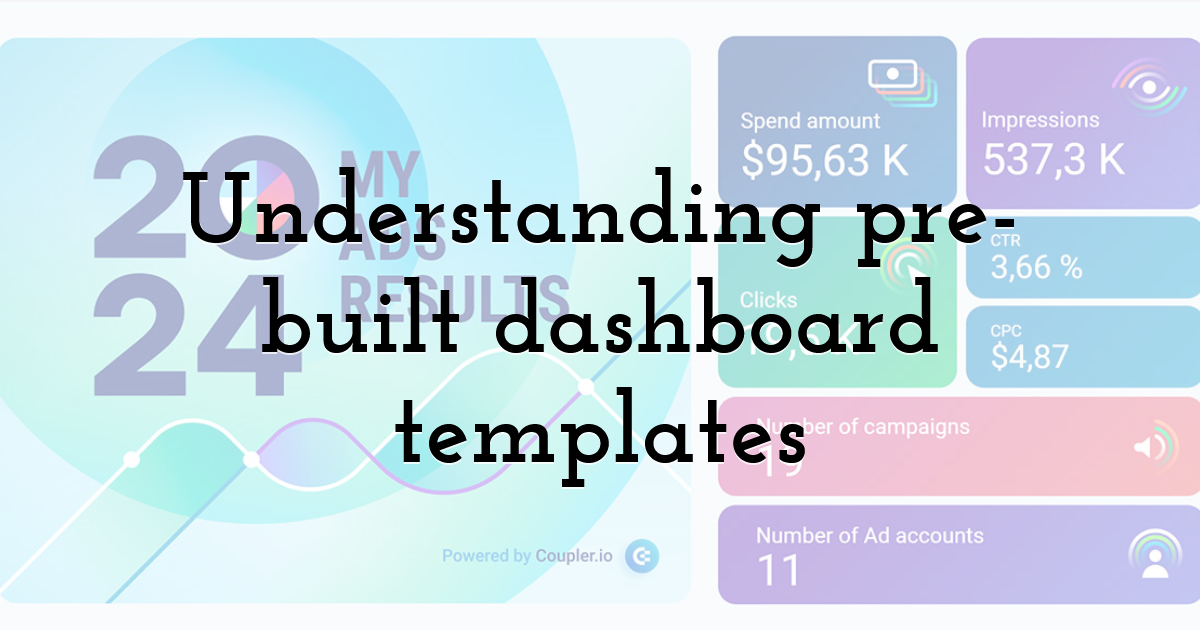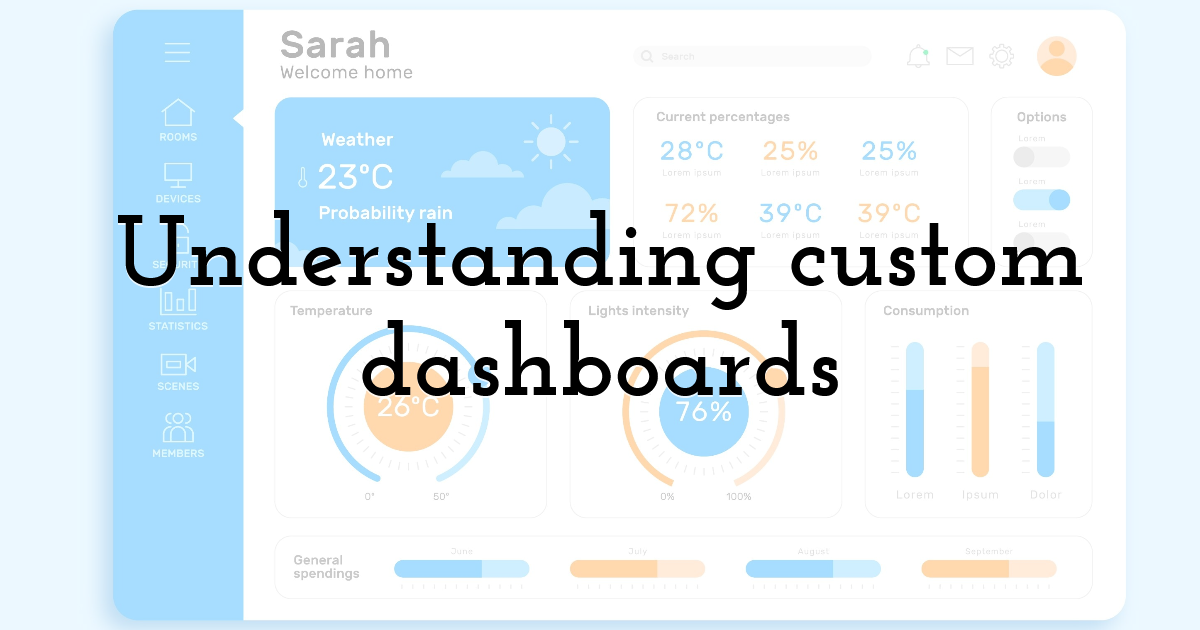Custom vs. Pre-Built Dashboard Templates: Pros and Cons

The swift rise of data analytics and visualization has allowed businesses to take advantage of critical KPIs and datasets and stay ahead of the curve. Any operation looking to follow current trends and make the most out of their data needs to consider implementing dashboard templates into their reporting actions.
Dashboard templates offer a unified layout for data visualization by using charts, graphs, and widgets, according to the best industry practices. They help teams integrate and analyze data quickly, without having to go through the exhausting processes of building presentations themselves.
The choice comes down to two options: pre-built and custom dashboard templates. Each offers a unique set of benefits and serves a specific audience. Which one you'll choose depends entirely on your business needs and budget.
Let's take a look at what factors play a vital role in deciding between custom and pre-built dashboards.
Understanding pre-built dashboard templates
Pre-built templates offer a ready-to-go solution, especially for teams seeking a quick, and momentarily solution. These templates come equipped with their sets of layouts and visualization options.

Pre-built dashboards often service a wide variety of industries since they implement standard sets of graphs, charts, or other elements. These examples of a Looker Studio dashboard showcase how such SaaS dashboards can cater to an endless list of businesses.
In most cases, companies that want to start their data visualization journey immediately and without learning curves and high upfront costs choose pre-built templates. We'll go deeper into their pros and cons down below.
Pros of pre-built dashboard templates
Pre-built templates offer some serious advantages, from shortening the time for implementation to being highly user-friendly. Let's check some of the main benefits:
Time-saving: One of the biggest perks of pre-built dashboards is they're ready to go almost immediately. They allow you to bypass the lengthy and tedious development processes and start implementing ideas from the get-go. Such templates are a perfect solution for businesses seeking immediate visual aid. Pre-built dashboard templates are designed with the most common business needs in mind, ensuring their features cater to most visualization needs.
Cost-effective: One of the main reasons why many businesses choose to go with pre-built templates is their affordability. Since development teams build them with general presentation needs in mind, and they distribute the costs among users, these solutions come at much lower expenses. This cost-effectiveness is perfect for small and medium teams and companies still trying to figure out their needs
Best industry practices: Dashboard development teams try their best to incorporate the latest and most useful industry features into their systems. Each element found in the dashboard needs to serve a purpose and drive clarity to reports and insights. That way, you can get by even without having a dedicated design team and still be able to hit all the major points in a clear visual manner.
User-friendly: Pre-built templates are famous for being straightforward and easy to use. Their main selling point is that they don't require any technical expertise for successful implementation. Intuitive and pre-configured settings allow everyone to get familiar with the interface and start visualizing data right away.
Cons of pre-built dashboard templates
Sometimes, what one sees as a benefit, others can see as a weakness. From limited customization to compatibility issues, pre-built templates have a set of drawbacks, depending on your needs.
Limited customization: Since pre-built templates are designed to accommodate wider audiences, you shouldn't expect them to be highly customizable. This is especially true for larger-scale operations. While smaller teams can usually get by, large enterprises often need specific data visualization features in their dashboards.
Scalability: Hopefully, your business will grow steadily over the years. And as it does, so do your dataset needs. Scaling pre-built templates to cover more detailed real-time analytics often requires additional costs, defeating the whole purpose of cost-effective templates.
Generic design: When you get a one-size-fits-all solution, then you're left with a visualization aid that resembles everyone else's. While this might not be a problem for most businesses, if you're looking to establish your brand identity on the market, you might feel pre-built templates are lacking in this department.
Potential compatibility issues: Pre-built templates usually include already-determined data integrations. So, if you're looking to connect any specialized datasets or software solutions, you might end up with connectivity issues.
Understanding custom dashboards

Custom templates, on the other hand, follow a detailed planning, development, and UX testing structure to ensure they fit your business perfectly. Large-scale operations often need to handle serious data sources and unique reporting demands, which brings the need for custom solutions.
They require a high financial and time investment. But, once you get it right, you end up with a tool ready to answer any of your reporting needs and grow and adapt in the process. Let's go through some major points regarding custom dashboards.
Pros of custom dashboards
Depending on your specific needs, you might need your dashboard to be highly customizable or ready to scale with you. Here are some of the benefits of dashboard customization:
Highly customizable: No one knows your business needs better than you and your colleagues and stakeholders. So, it makes sense that customizing dashboard analytics to your specific needs is a huge plus. With custom dashboards, you can tweak everything from color schemes to data visualization types, all in the name of quicker and simplified data visualization processes.
Scalability and flexibility: When your business grows, you don't want to be stuck with a one-size-fits-all solution. Such custom templates can slow down your data-driven decision-making actions and operations. Dashboard customization allows for various modifications and expansions during the growth of your company. In such a way, you get a data visualization tool that grows in unison with your business.
Better integration: Larger operations often need to integrate specific data sources. Custom templates offer a straightforward solution for this, eliminating the need for any additional business intelligence software. Custom dashboards offer a centralized tool where you can analyze data in one environment.
Branding and aesthetics: Nurturing brand identity and pleasing aesthetics are important aspects of data visualization processes, especially when we talk about large companies. With custom templates, you can implement everything from your brand colors, typography, and style. This not only improves user experience and engagement but also enhances your employees' alignment with the brand.
Cons of custom dashboards
Having a tailor-made solution comes with its set of cons. We've listed some of them:
Higher development costs: Hiring dashboard development specialists (whether in-house or on contract) can eat up a huge chunk of your budget. Allocating a significant financial investment from the start often proves to be too big of a hurdle for medium to smaller organizations, who often turn to pre-built templates.
Longer development time: Developing a custom solution can take a long time. You need to take planning, development, and all the different iterations into consideration. Only after covering all possible angles, you can head out and test your dashboard, before deploying it for team use. This might not be the best solution if you're time-constrained.
Ongoing maintenance: Once you've started implementing your custom solution, the real work begins. You can't just set it and forget it. Regular maintenance is necessary if you want to keep track of the latest technologies and data sources. The best solution would be to have a dedicated maintenance team; if not, you'll have to consider outsourcing.
Factors to consider when choosing between the two
With all the information presented, you still need to take a deeper look into your organization and its needs. Otherwise, you might end up with either a subpar solution that won't do the job or a feature-packed tool that's a bit too much for your current state of operations. Here's what you should consider:
Business size & budget: Smaller businesses and startups often go with pre-built templates due to budget constraints and not needing a robust set of features. So, it makes sense that they would opt for a more budget-friendly solution. On the other hand, large organizations prefer scalability and customization options, which allows them to take further growth into the equation. Also, higher initial costs usually don't pose an issue for established businesses.
Complexity of data: Consider what types of datasets your organization needs. If we're talking about straightforward reports and KPIs, you're likely to do just fine with pre-built templates. However, if you need in-depth analytics with specialized reporting, you'll probably need custom dashboards that allow more control over your data sources. Working with an Excel consultant can also help tailor spreadsheet solutions to better fit your reporting and analysis needs.
Time constraints: If you need to start tracking data right away, pre-made solutions will get you started in a couple of hours, if not less. Then again, if you can spare time to develop a solution that allows you to plan future needs, go with a custom tool that will scale along with your operations.
Technical expertise: Custom dashboards require regular updates and maintenance. If your budget doesn't allow for an IT team or an outside contractor, your safest bet would be pre-built templates. User-friendly interfaces and minimal tech knowledge required will lead to fewer headaches down the road.
Data archiving ∓ compliance: Another critical factor to consider is how your organization handles historical data and meets industry regulations. If your business operates in a heavily regulated sector, such as finance or healthcare, ensuring proper data archiving and compliance with legal standards is essential. Pre-built solutions might offer basic storage and retrieval options, but for organizations with strict compliance needs, a custom tool with advanced archiving capabilities and audit trails may be the better choice. Failing to implement the right solution could lead to inefficiencies in record-keeping and potential regulatory risks.
Final Thoughts
Choosing reporting tools should be considered as a strategic decision that will influence how you handle data within your company.
Whether you go with pre-built or custom dashboards will entirely be determined by accessing your company's budget, tech savviness, customization and scalability needs, and data requirements.
The need for data-driven decision-making will drive dashboard development to new frontiers. It will necessitate increased use of real-time analytics and AI insights. We can only expect predictive analytics and highly personalized dashboards to take over in no time.
Those who recognize these trends will lead the way for complex data handling, allowing them to get the upper hand over the competition.
Taking all the factors into consideration will let you not only improve your data game but also prepare your business for emerging trends and changes in the industry.
Until next time, Be creative! - Pix'sTory
Recommended posts
-

5 Major Usability Issues at the Design Stage
Read More › -

Web Design Trends that will Completely Dominate in 2021
Read More › -

How to Drive Traffic to Your Website: 7 Tactics That Make a Perfect Strat...
Read More › -

How Graphic Design Plays an Important Role in Social Media Marketing
Read More › -

How to Become a Web-Designer in 2021
Read More › -

Why is the Font Important for the Logo Design
Read More ›
